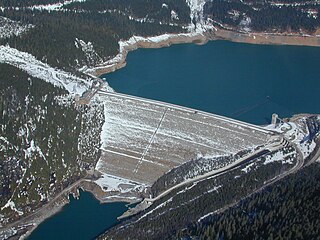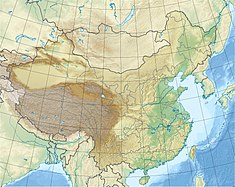
The Gezhouba Dam or Gezhouba Water Control Project on the Yangtze River is located in the western suburbs of Yichang City in central China's Hubei province. The dam sits a few kilometers upstream from downtown Yichang, just downstream of the fall of the Huangbo River into the Yangtze. Construction started on December 30, 1970 and ended on December 10, 1988. The dam has a total installed electrical capacity of 2,715 MW.

The Guangdong Pumped Storage Power Station or Guangzhou Pumped Storage Power Station is a pumped-storage hydroelectric power station near Guangzhou, Guangdong Province, China. Power is generated by utilizing eight turbines, each with a 300 megawatts (400,000 hp) capacity, totalling the installed capacity to 2,400 megawatts (3,200,000 hp). The generated power is sold to China Light and Power customers in Hong Kong. The power station was constructed in two stages, the first four turbines were completed in 1994 and the second four in 2000.

The Xiluodu Dam is an arch dam on the Jinsha River, i.e. the upper course of the Yangtze in China. It is located near the town of Xiluodu in Yongshan County of Yunnan Province but the dam straddles into Leibo County of Sichuan Province on the opposite side of the river. The primary purpose of the dam is hydroelectric power generation and its power station has an installed capacity of 13,860 MW. Additionally, the dam provides for flood control, silt control and its regulated water releases are intended to improve navigation downstream. Construction on the dam and power station began in 2005 and the first generator was commissioned in 2013, the last in 2014. It is operated by China Yangtze Power and is currently the third-largest power station with the fourth-tallest dam in the world.

Tanbara Dam is a rock-fill embankment dam on a Tone River tributary in Gunma Prefecture of Japan. It is located 14 kilometres (8.7 mi) north of Numata. It creates the upper reservoir for the 1,200 megawatts (1,600,000 hp) Tamahara Pumped Storage Power Station (玉原発電所). Construction began in 1973 and the dam was complete in 1981 while the power station was commissioned in 1986. It is 116 metres (381 ft) tall and withholds a reservoir with a storage capacity of 14,800,000 m3 (11,999 acre⋅ft). Of that capacity, 13,000,000 cubic metres (11,000 acre⋅ft) is active for power generation. The lower reservoir for the pumped-storage power station is created by the Fujiwara Dam, located 4 km (2 mi) to the northwest on another Tone River tributary. Power is generated during periods of high energy demand and pumping occurs during times when energy demand is low such as at night. The power station contains four 300 megawatts (400,000 hp) reversible Francis turbine pump-generators which serve to both pump water and generate electricity. The upper Tamahara Reservoir is at an elevation of 1,177 metres (3,862 ft) and the lower Fujiwara Reservoir is at 651 metres (2,136 ft) which affords the power station an effective hydraulic head of 518 metres (1,699 ft). When pumping, the pump-generators can move up to 210 cubic metres per second (7,400 cu ft/s) of water and when generating, they discharge up to 276 cubic metres per second (9,700 cu ft/s).
The Huizhou Pumped Storage Power Station is a pumped storage hydroelectric power station near Huizhou in Guangdong province, China. It contains 8 pump-generators that total a 2,448 megawatts (3,283,000 hp) installed capacity. Initial units went online between 2007 and 2008, and the power station was complete on June 15, 2011.

The Governor Bento Munhoz da Rocha Netto Hydroelectric Plant, formerly known as Foz do Areia, is dam and hydroelectric power plant on the Iguazu River near Foz do Areia in Paraná, Brazil. It is the furthest dam upstream of the Iguazu Falls and was constructed between 1976 and 1980. The power station has a 1,676 megawatts (2,248,000 hp) capacity and is supplied with water by a concrete face rock-fill embankment dam.

The Serra da Mesa Dam, once known as Sao Felix, is an embankment dam on the Tocantins River near Minaçu in Goiás, Brazil. The dam serves an associated hydroelectric power plant with a 1,275 megawatts (1,710,000 hp) installed capacity. The dam creates the largest reservoir by volume in Brazil.

The Tianhuangping Pumped Storage Power Station is a pumped-storage power station in Tianhuangping, Anji County of Zhejiang Province, China. The power station has an installed capacity of 1,836 megawatts (2,462,000 hp) utilizing 6 reversible Francis turbines. Construction began in 1993 and the power station was completed in 2004.

The Shuangjiangkou Dam(Chinese: 双江口大坝/双江口水电站), also referred to as Shuang Jiang Kou(Chinese: 双江口), is an embankment dam currently being constructed on the Dadu River in Sichuan Province, China. When completed, the 312 metres (1,024 ft) tall dam will be the tallest dam in the world. Preliminary construction began in 2008 and the entire project is expected to be complete in 2018. By April 2011, over 200,000,000 m3 (261,590,124 cu yd) of material had been excavated from the construction site. In March 2013 the China's Ministry of Environmental Protection approved construction on the dam's superstructure and associated facilities. The government acknowledged that the dam would have negative impacts on the environment but that developers were working to mitigate them. The dam is being built by the Guodian Group at a cost of US$4.02 billion. The entire construction period is expected to last 10 years.
The Shisanling Pumped Storage Power Station (十三陵抽水蓄能电厂) is a pumped-storage power station in Changping County of Beijing, China, near the Thirteen Tombs of the Ming Dynasty from where it got its name Shisanling, which means "thirteen tombs". The power station contains four reversible turbines for an installed capacity of 800 MW.

The Longyangxia Dam is a concrete arch-gravity dam at the entrance of the Longyangxia canyon on the Yellow River in Gonghe County, Qinghai Province, China. The dam is 178 metres (584 ft) tall and was built for the purposes of hydroelectric power generation, irrigation, ice control and flood control. The dam supports a 1,280 MW power station with 4 x 320 MW generators that can operate at a maximum capacity of 1400 MW. Controlling ice, the dam controls downstream releases to reservoirs lower in the river, allowing them to generate more power instead of mitigating ice. Water in the dam's 24.7 billion m3 reservoir provides irrigation water for up to 1,000,000 hectares of land.

The Liuxihe Dam is an arch dam on the Liuxihe River near Conghua, in Guangdong Province, China. The main purpose of the project is hydroelectric power generation with additional purposes of flood control and irrigation. The dam is 78 metres (256 ft) tall and was constructed between 1956 and 1958.

The Baishan Dam is an arch-gravity dam on the Second Songhua River near the town of Baishanzhen, Huadian, Jilin Province, China. The purpose of the dam is hydroelectric power generation and flood control. The dam supplies water to five turbine-generators in two different powerhouses for an installed capacity of 1,500 megawatts (2,000,000 hp) while it can also control a design 19,100 cubic metres per second (670,000 cu ft/s) flood. Additionally, it has a 300 megawatts (400,000 hp) pumped-storage hydroelectric generation capacity. It is named after Baekdu Mountain, near the city of Baishan.

The Shin-Takasegawa Pumped Storage Station (新高瀬川発電所) uses the Takase River to operate a pumped storage hydroelectric scheme about 12 kilometres (7.5 mi) west of Ōmachi in Nagano Prefecture, Japan. Part of the system is within Chūbu-Sangaku National Park.
The Heimifeng Pumped Storage Power Station is located at the hills of Heimifeng, Qiaoyi town, Wangcheng district, 25 kilometres (16 mi) north of Changsha in Hunan province, China. It was constructed between 2005 and 2009 with the generators being commissioned in 2009 and 2010. The station generates power by transferring water between an upper and lower reservoir. When energy demand is high, water from the upper reservoir is released and used to generate electricity before being discharged into the lower reservoir. During times of low demand, water from the lower reservoir is then pumped back up to replenish upper reservoir. This process allows the station to meet peak energy demand and it can go from standstill to operational in three minutes.
The Hohhot Pumped Storage Power Station, also known by Huhehaote, is located 20 kilometres (12 mi) north of Hohhot in Inner Mongolia, China. It uses the pumped-storage hydroelectric method to generate electricity. The plant has an installed capacity of 1,224 megawatts (1,641,000 hp). Construction began in 2005 and the first generator was commissioned on 20 November 2014. The second generator was commissioned on 26 December 2014 and the final two were commissioned in June 2015.

Irapé Dam, the tallest dam in Brazil, is an embankment dam on the Jequitinhonha River in the state of Minas Gerais. It is on the border of Berilo and Grão Mogol districts, about 26 kilometres (16 mi) west of Virgem da Lapa. The dam was constructed between 2002 and 2006 for the purpose of hydroelectric power generation.

Mambilla Power Station, one of Africa's biggest dam projects, is a projected hydro power plant which will be connected to three dams across the Donga River in Taraba State, Nigeria.

Wushe Dam is a gravity dam forming Wushe Reservoir, also called Wanda Reservoir and Bihu, on the Wushe Creek, a tributary of the Zhuoshui River, located in Ren-ai Township, Nantou County, Taiwan. The dam was completed in 1960 after seven years of construction, and serves mainly to generate hydroelectric power.
The Yixing Pumped Storage Power Station is a pumped-storage hydroelectric power station located Yixing city of Jiangsu Province, China. Construction on the power station began in 2003 and the first unit was commissioned in 2007, the last in 2008. The entire project cost US$490 million, of which US$145 million was provided by the World Bank. The power station operates by shifting water between an upper and lower reservoir to generate electricity. The lower reservoir was formed with the existing Huiwu Dam at the foot of Mount Tongguan. The Yixing Upper Reservoir is located atop Mount Tongguan which peaks at 530 metres (1,740 ft) above sea level. During periods of low energy demand, such as at night, water is pumped from Huiwu Lower Reservoir up to the upper reservoir. When energy demand is high, the water is released back down to the lower reservoir but the pump turbines that pumped the water up now reverse mode and serve as generators to produce electricity. Water from the nearby Huangtong River can also be pumped into the lower reservoir to augment storage. The process is repeated as necessary and the plant serves as a peaking power plant. The power station is operated by East China Yixing Pumped Storage Co Ltd.













